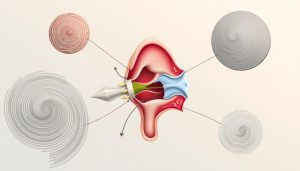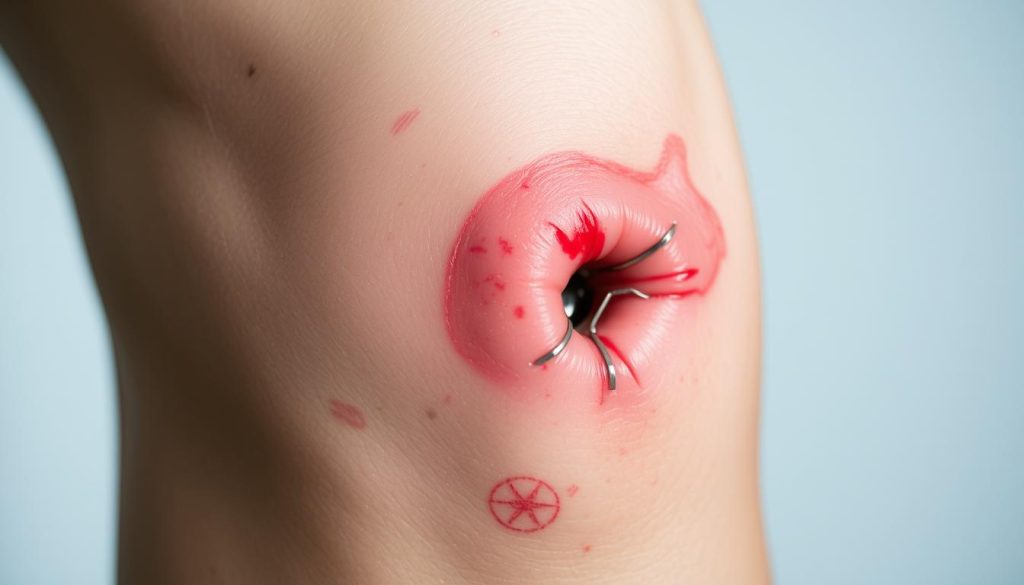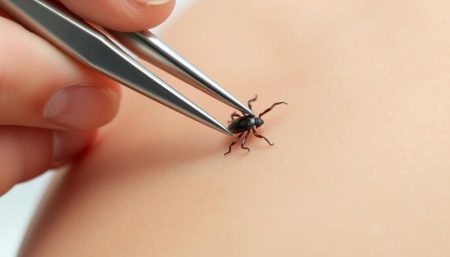Knee replacement surgery helps many people with severe joint pain. But, some face unexpected problems after the surgery. Issues like a hole in the knee can happen in a few cases. These problems can slow down recovery and worry both patients and doctors.
It’s important to know about knee surgery complications. Problems like infections or wound healing issues can occur. A hole in the knee is rare but serious. It needs quick medical care to avoid more issues and help healing.
Patients and doctors must watch for signs of complications. Finding and treating problems early can greatly improve outcomes. This guide will cover common post-surgery issues, their causes, and how to prevent and manage them.
Understanding Post-Operative Knee Complications and Wound Issues
Knee replacement surgery can cause many post-operative knee complications. It’s important for patients to know about knee wound healing problems for a smooth recovery. This section talks about common wound issues, risk factors, and warning signs.
Common Types of Wound Complications
After knee surgery, patients may face several wound-related problems:
- Dehiscence: Separation of wound edges
- Hematoma: Blood collection under the skin
- Delayed healing: Slow closure of the surgical site
- Infection: Bacterial growth in the wound
Risk Factors for Wound Healing Problems
Some factors can make knee wound healing problems more likely:
| Risk Factor | Impact on Healing |
|---|---|
| Obesity | Increased stress on wound, poor blood flow |
| Diabetes | Impaired circulation, slower healing |
| Smoking | Reduced oxygen supply to tissues |
| Advanced age | Decreased skin elasticity, slower cell regeneration |
Early Warning Signs of Wound Issues
It’s key to spot early signs of post-operative knee complications:
- Excessive redness or warmth around the incision
- Increased pain or swelling
- Fever or chills
- Unusual drainage or odor from the wound
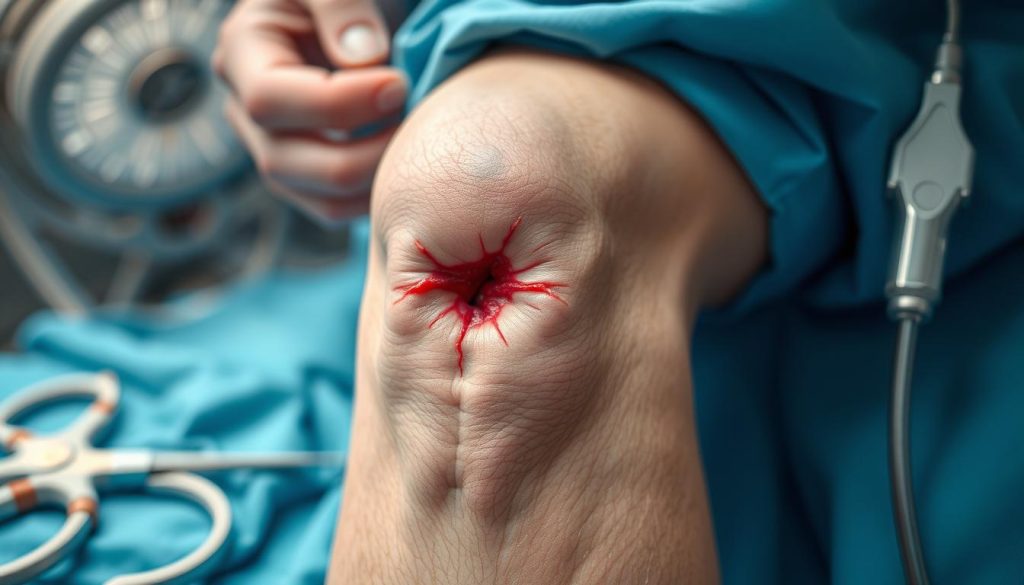
Spotting these symptoms early can prevent serious problems. Patients should reach out to their healthcare provider right away if they notice any of these signs. This way, they can tackle knee wound healing problems early.
Complications After Knee Replacement Surgery Hole in Knee: Essential Facts
Knee replacement surgery is meant to make moving easier and lessen pain. But, some people face issues like a hole in the knee after surgery. These problems can come from different causes and affect how well someone recovers.
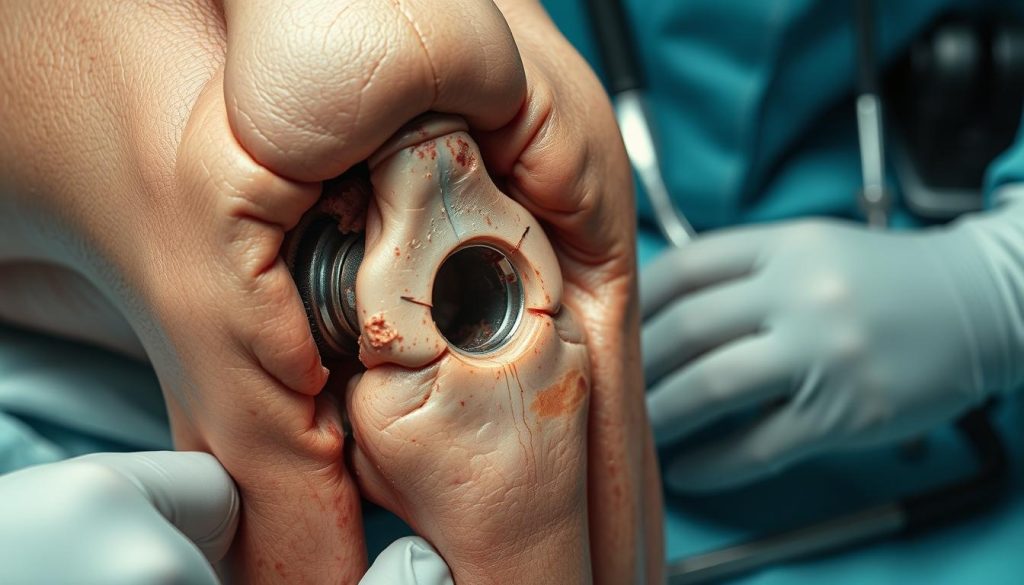
One big problem is when the artificial joint parts come loose from the bone. This can make a hole in the knee. People might feel more pain, have trouble walking, and feel unstable.
Infection is another serious issue. Bacteria can get into the surgical area, causing damage to tissues and bones. This can lead to visible holes around the knee. Signs of infection include fever, redness, and unusual discharge.
- Mechanical failure of the implant
- Bone loss due to stress shielding
- Trauma or injury to the operated knee
These factors can make recovery harder. Doctors use X-rays, CT scans, and blood tests to figure out how serious the problem is. They look for the cause of the knee hole.
Spotting problems early is key to treating them well. Patients should tell their surgeon about any odd symptoms right away. Quick action can help fix the issue and avoid more damage to the knee.
Identifying Signs of Infection Following Knee Replacement
Knee surgery can lead to serious complications, like infections. It’s important to know the signs of infection after knee replacement. This helps in getting the right treatment and recovering faster. Let’s look at the types of infections, their symptoms, and how to treat them.
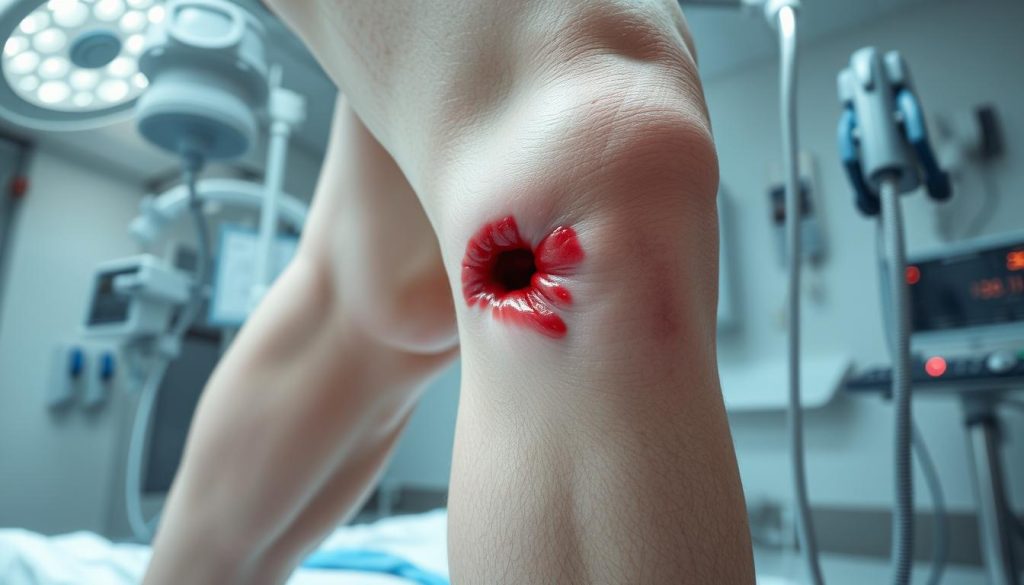
Superficial vs Deep Infections
Infections can be on the skin’s surface or deep in the joint. Superficial infections are on the skin’s outer layer. Deep infections go into the joint space. Both need medical help, but deep infections are more dangerous for the implant and health.
Bacterial Infections and Their Symptoms
Common bacteria causing infection after knee replacement include Staphylococcus aureus and Streptococcus. Watch for these symptoms:
- Increased pain or swelling around the knee
- Redness or warmth in the affected area
- Fever or chills
- Drainage from the surgical site
- Fatigue or general feeling of illness
Treatment Options for Infected Knee Replacements
Treatment varies based on the infection’s severity and type. Options include:
- Oral antibiotics for mild, superficial infections
- Intravenous antibiotics for more severe cases
- Surgical debridement to remove infected tissue
- Implant removal and replacement in severe cases
Early detection and treatment of infections are key. They help avoid complications and ensure a successful recovery from knee replacement surgery.
Blood Clot Formation and Prevention Strategies
Blood clots after knee surgery are a serious issue. They can form in the deep veins of the legs. This can lead to life-threatening conditions if not treated.
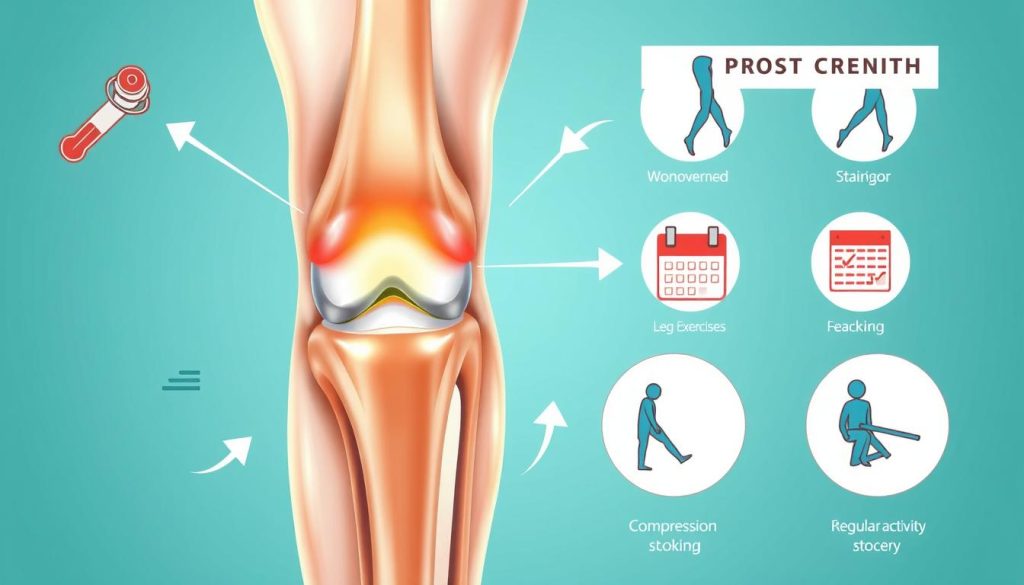
Several factors increase the risk of blood clots after knee surgery. Limited mobility and the body’s healing response are key factors. Obesity, smoking, and a history of blood clots also raise the risk.
Preventing blood clots is essential. Doctors often suggest early mobilization. This means moving as soon as it’s safe after surgery. It helps keep blood flowing and lowers clot risk.
- Compression devices on the legs
- Anticoagulant medications
- Regular leg exercises
- Proper hydration
It’s important to recognize the signs of blood clots. Look for swelling, warmth, redness, or pain in the legs. Shortness of breath or chest pain could mean a clot has moved to the lungs. This is a medical emergency.
“Patient education and vigilance are key in preventing and detecting blood clots after knee surgery.”
Understanding the risks and following prevention strategies can lower the chance of blood clots. Regular talks with healthcare providers during recovery help catch and treat any issues quickly.
Managing Post-Surgical Knee Stiffness and Motion Problems
Knee stiffness is common after knee replacement surgery. Many patients find it hard to move their knee freely. It’s important to know how to deal with this stiffness for a good recovery.
Physical Therapy Interventions
Physical therapy is key in fighting knee stiffness. Therapists use special exercises and techniques to boost flexibility and strength. These efforts help patients move better and feel less pain.
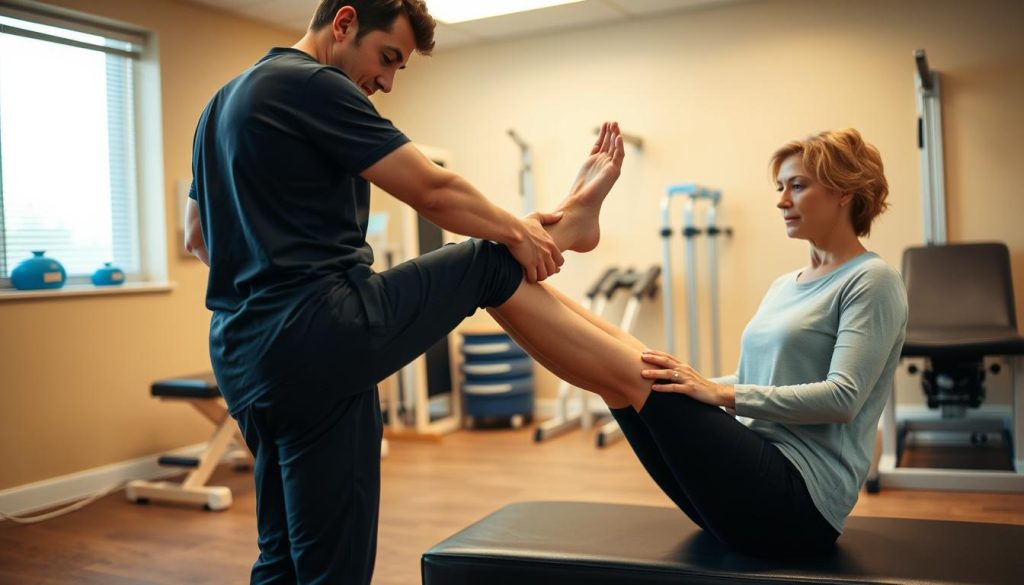
Range of Motion Exercises
Exercises are designed to make the knee more flexible. Patients do gentle bending and straightening. They also get help from therapists. Doing these exercises regularly is essential to beat knee stiffness.
| Exercise | Frequency | Benefit |
|---|---|---|
| Heel Slides | 3 sets of 10 reps, twice daily | Improves knee flexion |
| Seated Knee Extensions | 3 sets of 15 reps, once daily | Enhances knee extension |
| Wall Slides | 2 sets of 10 reps, once daily | Increases overall range of motion |
Preventing Joint Stiffness
Moving the knee early is vital to avoid stiffness. Patients should start moving their knee as soon as they can, with their doctor’s advice. Keeping the knee moving and managing pain helps keep it flexible and prevents stiffness.
Prosthetic Joint Complications and Failure Modes
Knee replacement surgery aims to improve mobility and reduce pain. Yet, complications can arise, leading to knee replacement failure. Understanding these issues helps patients recognize problems early.
Implant loosening is a common cause of complications after knee replacement surgery. This occurs when the bond between the implant and bone weakens. Patients may feel pain or instability when walking. In severe cases, a hole in the knee can develop as the implant shifts.
Wear and tear of the implant materials is another concern. Over time, tiny particles can break off, causing inflammation and bone loss. This process, known as osteolysis, may result in implant failure and the need for revision surgery.
Implant breakage, though rare, is a serious complication. It can happen due to manufacturing defects or extreme stress on the joint. Symptoms include sudden pain, swelling, and inability to bear weight.
| Failure Mode | Main Symptoms | Potential Causes |
|---|---|---|
| Implant Loosening | Pain, instability | Weak bone-implant bond |
| Wear and Tear | Gradual pain increase | Material degradation |
| Implant Breakage | Sudden pain, swelling | Manufacturing defects, extreme stress |
Factors contributing to these complications include implant design, surgical technique, and patient-specific issues like bone quality and activity level. Regular follow-ups with your surgeon can help detect and address problems early. This can prevent more serious complications after knee replacement surgery.
Wound Drainage and Healing Complications
After knee replacement surgery, patients may face wound drainage issues. It’s important to understand these complications for healing and recovery. We’ll look at the types of drainage, normal and abnormal patterns, and how to manage persistent drainage.
Types of Wound Drainage
Knee wound healing problems can show up in different ways:
- Serous: Clear, yellowish fluid
- Sanguineous: Blood-tinged drainage
- Purulent: Thick, cloudy discharge indicating infection
Normal vs Abnormal Drainage Patterns
It’s important to know the difference between normal and abnormal drainage:
| Normal Drainage | Abnormal Drainage |
|---|---|
| Clear or slightly pink | Yellow, green, or foul-smelling |
| Decreases over time | Increases or persists beyond 7 days |
| Minimal amount | Large volumes or continuous seepage |
Management of Persistent Drainage
For persistent drainage, doctors might suggest:
- Frequent dressing changes
- Antibiotics for suspected infection
- Wound vacuum therapy
- Surgical intervention in severe cases
Good wound care is key to avoiding more problems and ensuring a smooth recovery after knee replacement surgery.
Pain Management and Chronic Discomfort Issues
Pain management is key after knee replacement surgery. Many feel pain after surgery, but it’s important to know the difference. Normal pain and chronic issues are two different things.
At first, pain can be sharp and then turn into a dull ache. But, if pain gets worse or stays the same, it might be a sign of a problem.
- Prescription medications
- Physical therapy exercises
- Ice and heat therapy
- Elevation and compression
Some people find relief with acupuncture or massage. Always follow your doctor’s advice and talk about any pain concerns.
Chronic pain can also affect your mind, causing anxiety or depression. Joining support groups or seeing a counselor can help. They can make your recovery better.
| Pain Type | Duration | Action Required |
|---|---|---|
| Acute post-operative | 1-2 weeks | Follow prescribed pain management plan |
| Moderate discomfort | 2-6 weeks | Continue therapy, monitor progress |
| Persistent severe pain | Beyond 6 weeks | Consult surgeon for evaluation |
Managing pain well is important for a good recovery after knee surgery. If pain is unusual or gets worse, get medical help. This can help find and fix any problems early.
Revision Surgery: When and Why It’s Necessary
Knee replacement revision surgery is needed when the first implant fails or problems occur. This detailed surgery fixes issues that can happen after the first surgery.
Indications for Revision Surgery
Doctors suggest revision surgery for several reasons:
- Implant loosening or wear
- Persistent pain or instability
- Infection in the joint
- Fractures around the implant
- Allergic reactions to implant materials
Knee replacement failure can happen for these reasons. Revision surgery is key to fixing these problems and easing pain.
Preparation and Recovery Expectations
Getting ready for knee replacement revision surgery involves detailed checks. Patients have imaging tests and lab work to check their health. Recovery takes longer than the first surgery, needing patience and effort in physical therapy.
Success Rates and Outcomes
Revision surgeries are complex but can greatly improve life quality. Success rates depend on why the revision is needed and the patient’s health.
| Reason for Revision | Success Rate | Recovery Time |
|---|---|---|
| Aseptic Loosening | 85-90% | 3-6 months |
| Infection | 70-80% | 6-12 months |
| Instability | 80-85% | 4-8 months |
Those thinking about knee replacement revision surgery should talk to a skilled orthopedic surgeon. They can explain the benefits and risks.
Preventive Measures and Risk Reduction Strategies
Preventing complications after knee replacement surgery is possible with proactive steps. Being well-prepared and following medical advice can help avoid issues like a hole in the knee. This includes other complications related to knee surgery.
Managing your weight is important. Excess weight can stress the new joint, leading to wear or failure. It’s best to have a healthy BMI before surgery and keep it afterward.
Quitting smoking is essential for healing. Nicotine slows down healing and increases infection risk. Stopping at least six weeks before surgery can improve your outcome.
It’s important to follow post-operative instructions carefully. This includes taking care of your wound, following medication, and doing physical therapy. These steps help prevent infections and speed up recovery.
| Preventive Measure | Benefits |
|---|---|
| Weight Management | Reduces stress on the joint, lowers risk of early wear |
| Smoking Cessation | Improves blood flow, speeds up healing, lowers infection risk |
| Proper Wound Care | Prevents infection, promotes faster healing |
| Regular Follow-ups | Allows early detection of possible issues |
Regular check-ups are key for catching problems early. Talking openly with your healthcare team helps catch issues quickly. This reduces the chance of serious problems after knee replacement surgery.
Emergency Signs Requiring Immediate Medical Attention
After knee replacement surgery, it’s key to watch for post-operative knee complications. Knowing the warning signs can stop serious problems, like infection after knee replacement. Here’s what you need to know about emergencies after your procedure.
Critical Warning Signs
Look out for these red flags that may show serious issues:
- Severe, increasing pain in your knee
- Fever over 101°F (38.3°C)
- Excessive swelling or redness around the incision
- Warmth or tenderness in your calf
- Shortness of breath or chest pain
When to Contact Your Surgeon
Call your surgeon if you see:
- Persistent drainage from the incision site
- Unusual odor or color change around the wound
- Inability to bear weight on your operated leg
- Numbness or tingling in your foot or toes
Emergency Room vs. Clinic Visits
Go to the ER right away for severe symptoms like chest pain, trouble breathing, or signs of a blood clot. For less urgent issues, call your surgeon’s office. They’ll tell you if to book a clinic visit or go to the ER. Quick action can stop minor problems from becoming big post-operative knee complications.
“Never ignore persistent pain, fever, or wound changes after knee surgery. When in doubt, it’s always better to seek medical advice promptly.”
Long-term Recovery and Rehabilitation Protocols
Knee replacement recovery can take a long time. It often lasts several months to a year. Following specific protocols is key to the best results and to avoid problems.
- Walking with assistance: 1-2 weeks
- Driving: 4-6 weeks
- Returning to work: 6-8 weeks
- Full recovery: 3-12 months
Rehabilitation is vital for knee stiffness after surgery. Exercise programs help strengthen and stretch muscles. It’s important to slowly increase activity and avoid high-impact sports.
Challenges in long-term recovery include:
- Persistent stiffness
- Muscle weakness
- Limited range of motion
To tackle these issues, adjusting exercise or getting more physical therapy might be needed. A healthy lifestyle, including good nutrition and managing weight, helps protect the knee and extend its life.
| Recovery Phase | Focus Areas | Activities |
|---|---|---|
| Early (0-3 months) | Pain management, basic mobility | Gentle exercises, walking, stair climbing |
| Intermediate (3-6 months) | Strength building, flexibility | Resistance training, stationary cycling |
| Advanced (6+ months) | Functional improvement | Low-impact sports, balance exercises |
Latest Treatment Advances for Knee Surgery Complications
Medical science keeps getting better, giving hope to those with knee surgery issues. Doctors now use computer-assisted navigation for knee replacement revision surgery. This tech helps place implants more accurately, which might lower the chance of future problems.
New ways to handle infections have come up. Antibiotic-loaded spacers are used in two-stage revision procedures. These spacers fight infection and keep the joint space open. This method is showing great promise in treating tough knee infections after surgery.
Pain management and healing tissues have seen big breakthroughs. Stem cell treatments and growth factor applications are being looked into to speed up recovery. These new therapies aim to lessen pain and help tissues heal faster after knee replacement complications.
As research goes on, patients have more to look forward to. New methods and technologies are making knee replacement revision surgery more successful. These advances bring new hope to those facing knee surgery complications.
FAQ
Q: What are the most common complications after knee replacement surgery?
A: Common issues after knee surgery include infection and blood clots. Stiffness, ongoing pain, and implant loosening are also common. Rarely, a hole in the knee can occur due to implant failure or severe infection.
Q: How long does it typically take to recover from knee replacement surgery?
A: Recovery time varies, but most people can get back to normal in 3-6 months. Full recovery might take up to a year, depending on individual factors and rehabilitation.
Q: What are the signs of infection after knee replacement?
A: Signs of infection include increased pain, swelling, and redness. Warmth around the incision site, fever, chills, and drainage are also warning signs. If you notice these, seek medical help right away.
Q: How can I prevent blood clots after knee surgery?
A: To avoid blood clots, follow your doctor’s advice. This may include moving early, wearing compression stockings, and taking blood-thinning meds. Stay hydrated and avoid sitting for too long.
Q: What causes knee stiffness after replacement surgery?
A: Stiffness can come from scar tissue, not enough physical therapy, or being too immobile. Infection or implant problems can also cause it. Keeping up with physical therapy and following instructions is key.
Q: When is revision surgery necessary after knee replacement?
A: Revision surgery is needed for implant failure, severe infection, or persistent pain. It’s also needed for significant instability. The decision depends on the patient’s situation and complications.
Q: What are the warning signs that require immediate medical attention after knee replacement?
A: Severe pain, signs of infection, breathing issues, or sudden leg immobility need immediate care. These could be signs of a blood clot or other serious problems.
Q: How can I optimize my recovery and reduce the risk of complications?
A: Follow your surgeon’s advice, attend all follow-ups, and do physical therapy. Eat well, avoid smoking, and talk to your healthcare team about any concerns. This helps your recovery and reduces risks.
Q: What is the success rate of knee replacement surgery?
A: Over 90% of patients see significant pain relief and function improvement. But, results can vary, and some may face complications or need a second surgery.
Q: How long do knee replacements typically last?
A: Modern knee replacements can last 15-20 years or more. But, factors like age, activity level, and health affect how long they last. Some may need a second surgery after 10-15 years.











